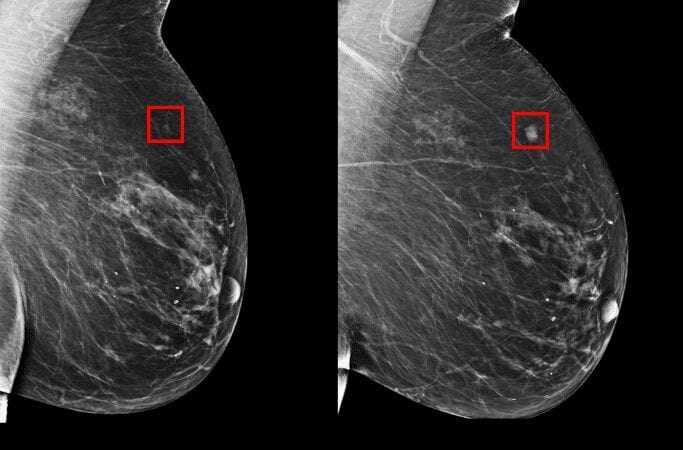
Credit: American Chemical Society
For detecting cancer, manual breast exams seem low-tech compared to other methods such as MRI. But scientists are now developing an “electronic skin” that “feels” and images small lumps that fingers can miss.
Knowing the size and shape of a lump could allow for earlier identification of breast cancer, which could save lives. They describe their device, which they’ve tested on a breast model made of silicone, in the journal ACS Applied Materials & Interfaces.
Ravi F. Saraf and Chieu Van Nguyen point out that early diagnosis of breast cancer, the most common type of cancer among women, can help save lives. But small masses of cancer cells are not always easy to catch. Current testing methods, including MRI and ultrasounds, are sensitive but expensive. Mammography is imperfect, especially when it comes to testing young women or women with dense breast tissue. Clinical breast exams performed by medical professionals as an initial screening step are inexpensive, but typically don’t find lumps until they’re 21 millimeters in length, which is about four-fifths of an inch. Detecting lumps and determining their shape when they’re less than half that size improves a patient’s survival rate by more than 94 percent. Some devices already mimic a manual exam, but their image quality is poor, and they cannot determine a lump’s shape, which helps doctors figure out whether a tumor is cancerous. Saraf and Nguyen wanted to fill this gap.
Toward that end, they made a kind of electronic skin out of nanoparticles and polymers that can detect, “feel” and image small objects. To test how it might work on a human patient, they embedded lump-like objects in a piece of silicone mimicking a breast and pressed the device against this model with the same pressure a clinician would use in a manual exam. They were able to image the lump stand-ins, which were as little as 5 mm and as deep as 20 mm. Saraf says the device could also be used to screen patients for early signs of melanoma and other cancers.
The Latest on: Breast cancer detection
[google_news title=”” keyword=”Breast cancer detection” num_posts=”10″ blurb_length=”0″ show_thumb=”left”]
via Google News
The Latest on: Breast cancer detection
- Awareness on breast canceron April 27, 2024 at 6:11 pm
The Cancer Meet-2024 was organised by the Nargis Dutt Foundation in collaboration with the Jeeto Foundation at the Mohali Club on Saturday.
- Kansas lawmaker asks, 'Is it sexism?' after peers pull $75K for breast cancer screeningson April 26, 2024 at 5:39 am
Kansas legislators planned to spend $75,000 on breast cancer screenings for state staff but removed in the final state budget.
- Breast cancer rates rising among Canadian women in their 20s, 30s and 40son April 25, 2024 at 5:00 pm
Rates of breast cancer in women under the age of 50 are rising in Canada according to a study which showed an increase in breast cancer diagnoses among females in their twenties, thirties, and forties ...
- Jockey who made history at Derby helping others access breast cancer screenings, resourceson April 25, 2024 at 2:50 pm
P.J. Cooksey is a breast cancer survivor who now encourages workers on the backside of the track to get screened through Horses and Hope.
- HealthWatch: Beating breast cancer with Aurora BayCare Medical Centeron April 25, 2024 at 12:02 pm
Early detection and knowing your family history are key when it comes to beating breast cancer. Catching it early saved Stephanie Skrede’s life. “Mom called ...
- 2024 United States Breast Cancer Outlookon April 24, 2024 at 8:19 am
Invasive female breast cancer has been rising by nearly 0.6% per year since the mid-2000s, according to a recent report by the American Cancer Society. This is partly due to an ov ...
- Actress Olivia Munn's Breast Cancer Diagnosis Highlights Importance of Breast MRIson April 18, 2024 at 12:08 pm
Actress Olivia Munn’s Breast Cancer Announcement Highlights Importance of Breast MRI in Detecting Cancer in High Risk Patients.
- What Olivia Munn's Doctor Wants You to Know About Your Breast Cancer Risk Assessment Score (Exclusive)on April 17, 2024 at 5:00 am
Dr. Thaïs Aliabadi, who discovered Olivia Munn’s breast cancer, says helping women understand the tools to help with prevention is her “mission in life” ...
- Report suggests people with breast cancer are being ‘systematically left behind’on April 15, 2024 at 11:52 pm
The Lancet Breast Cancer Commission says people with the disease are continuing to face glaring inequalities and significant adversity.
- Many With Breast Cancer 'Systematically Left Behind,' Report Sayson April 14, 2024 at 9:00 pm
Commission members noted that despite progress in research and cancer management that has substantially decreased breast cancer mortality in high-income countries, the World Health Organization still ...
via Bing News









